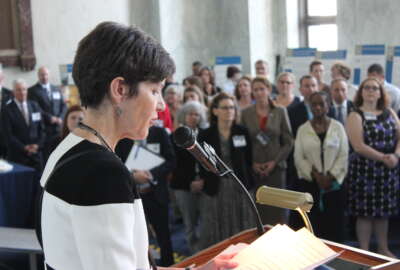

The Veterans Health Administration's Innovation Ecosystem is bigger than ever, and employees are still eager to pitch their own ideas -- even when the funding n...
VA has no choice but to change the way it does its business, said Tom Osborne, director of the VA National Center for Collaborative Healthcare Innovation.
“Change will be hard for some, and as a result some may lobby that we stay the course,” he said last week at the department’s “Innovation Experience” in Washington. “But there should be no misguided notions for us. Doing things the way we always have will never solve these colossal problems.”
Luckily, employees at the Veterans Health Administration have no shortage of new ideas, big and small.
There’s “InformaVet,” a text messaging tool to keep families and up to date throughout a veteran’s surgery or lengthy procedure.
Or a program to virtually check patients’ blood pressure.
These are just two of the dozens of the ideas VA employees presented last week at the two-day “Innovation Experience” in Washington. They’re hoping their pitches will earn them a spot on the Veterans Health Administration’s Innovators Network and “Spark-Seed-Spread” investment program, which gives employees the space and resources to cultivate their ideas.
Since 2015, VA employees have submitted more than 2,000 ideas since to the department’s “shark tank” competition. At least 47 ideas have reached “gold star” status in the VHA’s Diffusion of Excellence initiative.
“While we’re asking veterans to trust in us and we seek to continuously earn their care, it’s also vitally important that our employees choose VA each and every day as a place to innovate, that you all believe that when you contribute excellence to this organization [and] when you do something great, that it’s going to be valued as such, that it’s going to be given a platform and you do have the possibility of replicating it,” Blake Henderson, acting director of VA’s Diffusion of Excellence program, said.
At least a handful of VA-employee generated ideas have been implemented across much of the VA medical system.
A tooth brushing program designed to prevent hospital-acquired pneumonia among veterans has been adopted at 42 VA sites. So far, the department estimates it’s prevented at least 268 pneumonia infections in patients.
VHA’s Rapid Naloxone initiative, which simply equips VA police officers with injection kits in the event of opioid overdose, has spread to 116 VA medical facilities.
Naloxone is a medication used to immediately block or reverse the effects of an opioid overdose.
VA’s 3D Printing Network has also taken off in the past year, the department said. Three VA hospitals had 3D printing labs back in 2017; today there are more than 30.
“From a scaling perspective that’s actually enormous, because the amount of technology and the resources and the expertise it takes to do 3D printing [with] quality and to ensure that the precision of the replicable model is there, it’s enormous,” Ryan Vega, executive director of the VHA Innovation Ecosystem, said in an interview. “The fact that it has scaled that large is a testament to the network and some of innovative infrastructure that exists with VA.”
And another practice designed to reduce the risks associated with too many prescriptions has prevented veterans from using more than 116,000 unnecessary medications. The program has spread to 32 VA facilities and impacted 54,000 veterans.
To generate more interest and awareness in these employee-generated innovations, VA will formally launch an online “Diffusion Marketplace” in January. The marketplace will feature 53 vetted best practices from VA employees that have been replicated at two VA sites or more.
Vega said the goal was to create an online catalog of VA-generated ideas and model the site after an Amazon-like web experience.
“It’s the feel of buying something online,” he said. “It has a couple of other elements. You go on, you see the practice, you can see how much it costs [and] what the complexity is. This is actually something really important that we don’t ever talk about. I may know what my neighbor down the street is doing, but I don’t know how much it costs. I don’t know if it’s right for my facility. Making all that information now transparent in a mechanism or a format that we all interact with on a day-to-day basis, we think is really powerful for not only connecting people across the country but for helping spread these practices.”
Innovation is often messy and chaotic, Vega said, and not all ideas get seed funding to grow. For the first time, VA saw a large number of “zero-dollar” investments, which Vega said shows just how interested employees are in developing and improving on their own ideas.
“There’s access to a network,” he said. “There’s access to opportunities to tell your story, to meet other folks who bring your idea further along to where it is ready for an investment.”
VA is also partnering with FedTech, a start-up studio for federal agencies, which will provide formal training for employees on how to further pitch, test and validate their ideas.
“It’s taking a leap behind what’s a really good idea to is it the right solution to implement for the veteran, the caregiver or for the workforce,” Vega said. “There’s so much these individuals can still do that doesn’t cost a dollar.”
Copyright © 2024 Federal News Network. All rights reserved. This website is not intended for users located within the European Economic Area.
Nicole Ogrysko is a reporter for Federal News Network focusing on the federal workforce and federal pay and benefits.
Follow @nogryskoWFED


